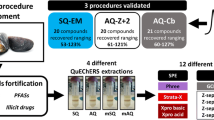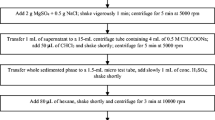Abstract
Two miniaturized extraction methods for a wide range of 2-6 ring polycyclic aromatic hydrocarbons (PAHs) and their alkylated homologues in small lipid-rich biota samples (≤100 mg) have been developed. Both methods utilize liquid extraction (LE) prior to a clean-up step using either normal phase solid phase extraction (SPE) or mixed-phase dispersive SPE (dSPE). Optimization of the methods was achieved by comparing the type and amount of sorbents, drying agents, and solvents used. In order to improve the limits of detection (LOD) of target PAHs under high sensitivity gas chromatography–tandem mass spectrometry analysis, specific emphasis was given to minimizing lipid co-extraction. The optimized LE–SPE method comprised extraction with dichloromethane/n-hexane (1:1, v/v) and clean-up by silica SPE, whereas the optimized LE–dSPE method comprised extraction with acetonitrile and clean-up with PSA and C18 sorbents. The methods were validated and directly compared through the analysis of Atlantic cod (Gadus morhua) and haddock (Melanogrammus aeglefinus) eggs exposed to oil. The LE–SPE method resulted in lower levels of co-extracted lipids (14.1 ± 1.7 ng/μL) than the LE–dSPE method (60 ± 14 ng/μL). Achieved PAH LODs for the LE–SPE method were typically an order of magnitude lower (<5 ng/g) than for the LE–dSPE method (<125 ng/g). The LE–SPE method offers the possibility for PAH analysis of small samples of fish eggs (~100 mg) exposed to small quantities of crude oil (~1–10 μg/L total PAHs).






Similar content being viewed by others
References
Barron MG, Carls MG, Heintz R, Rice SD (2004) Evaluation of fish early life-stage toxicity models of chronic embryonic exposures to complex polycyclic aromatic hydrocarbon mixtures. Toxicol Sci 78(1):60–67
Wu D, Wang Z, Hollebone B, McIntosh S, King T, Hodson PV (2012) Comparative toxicity of four chemically dispersed and undispersed crude oils to rainbow trout embryos. Environ Toxicol Chem 31(4):754–765
Redman AD (2015) Role of entrained droplet oil on the bioavailability of petroleum substances in aqueous exposures. Mar Pollut Bull 97(1–2):342–348
Sørhus E, Edvardsen RB, Karlsen Ø, Nordtug T, van der Meeren T, Thorsen A, Harman C, Jentoft S, Meier S (2015) Unexpected interaction with dispersed crude oil droplets drives severe toxicity in Atlantic haddock embryos. PLoS One 10(4):e0124376
Sørensen L, Silva MS, Meier S, Booth AM (2015) Advances in miniaturization and increasing sensitivity in analysis of organic contaminants in marine biota samples. Trends Environ Anal Chem 6–7:39–47
Aguinaga N, Campillo N, Vinas P, Hernandez-Cordoba M (2008) Evaluation of solid-phase microextraction conditions for the determination of polycyclic aromatic hydrocarbons in aquatic species using gas chromatography. Anal Bioanal Chem 391(4):1419–1424
Campíns-Falcó P, Verdú-Andrés J, Sevillano-Cabeza A, Molins-Legua C, Herráez-Hernández R (2008) New micromethod combining miniaturized matrix solid-phase dispersion and in-tube in-valve solid-phase microextraction for estimating polycyclic aromatic hydrocarbons in bivalves. J Chromatogr A 1211(1–2):13–21
Pensado L, Casais MC, Mejuto MC, Cela R (2005) Application of matrix solid-phase dispersion in the analysis of priority polycyclic aromatic hydrocarbons in fish samples. J Chromatogr A 1077(2):103–109
Scott JA, Incardona JP, Pelkki K, Shepardson S, Hodson PV (2011) AhR2-mediated, CYP1A-independent cardiovascular toxicity in zebrafish (Danio rerio) embryos exposed to retene. Aquat Toxicol 101(1):165–174
Molina-Ruiz JM, Cieslik E, Cieslik I, Walkowska I (2015) Determination of pesticide residues in fish tissues by modified QuEChERS method and dual-d-SPE clean-up coupled to gas chromatography-mass spectrometry. Env Sci Pollut Res Int 22(1):369–378
Angioni A, Cau A, Secci M, Addis P (2014) GC-ITMS analysis of PAH contamination levels in the marine sea urchin Paracentrotus lividus in Sardinia. Mar Pollut Bull 82(1–2):201–207
Gonzalo-Lumbreras R, Sanz-Landaluze J, Cámara C (2014) Analytical performance of two miniaturised extraction methods for triclosan and methyltriclosan, in fish roe and surimi samples. Food Chem 146:141–148
Lucci P, Pacetti D, Núñez O, Frega NG (2012) Current trends in sample treatment techniques for environmental and food analysis. In: Calderon DL (ed) Chromatography - the most versatile method of chemical analysis. Intech, Rijeka
Sapozhnikova Y, Lehotay SJ (2013) Multi-class, multi-residue analysis of pesticides, polychlorinated biphenyls, polycyclic aromatic hydrocarbons, polybrominated diphenyl ethers and novel flame retardants in fish using fast, low-pressure gas chromatography–tandem mass spectrometry. Anal Chim Acta 758:80–92
Kalachova K, Pulkrabova J, Cajka T, Drabova L, Stupak M, Hajslova J (2013) Gas chromatography-triple quadrupole tandem mass spectrometry: a powerful tool for the (ultra)trace analysis of multiclass environmental contaminants in fish and fish feed. Anal Bioanal Chem 405(24):7803–7815
Mastovska K, Wylie PL (2012) Evaluation of a new column backflushing set-up in the gas chromatographic–tandem mass spectrometric analysis of pesticide residues in dietary supplements. J Chromatogr A 1265:155–164
Salze G, Tocher DR, Roy WJ, Robertson DA (2005) Egg quality determinants in cod (Gadus morhua L.): egg performance and lipids in eggs from farmed and wild broodstock. Aquac Res 36(15):1488–1499
Hansen BH, Salaberria I, Olsen AJ, Read KE, Overjordet IB, Hammer K, Altin D, Nordtug T (2015) Reproduction dynamics in copepods following exposure to chemically and mechanically dispersed crude oil. Environ Sci Technol 49(6):3822–3829
Folch J, Lees M, Stanley GHS (1957) A simple method for the isolation and purification of total lipides from animal tissues. J Biol Chem 226(1):497–509
Olsen RE, Henderson RJ (1989) The rapid analysis of neutral and polar marine lipids using double-development HPTLC and scanning densitometry. J Exp Marine Biol Ecol 129(2):189–197
Meier S, Mjøs SA, Joensen H, Grahl-Nielsen O (2006) Validation of a one-step extraction/methylation method for determination of fatty acids and cholesterol in marine tissues. J Chromatogr A 1104(1–2):291–298
Bachan M, Fleming I, Trippel E (2012) Maternal allocation of lipid classes and fatty acids with seasonal egg production in Atlantic cod (Gadus morhua) of wild origin. Mar Biol 159(10):2281–2297
Jin J, Zhang Z, Li Y, Qi P, Lu X, Wang J, Chen J, Su F (2010) Enrichment of polycyclic aromatic hydrocarbons in seawater with magnesium oxide microspheres as a solid-phase extraction sorbent. Anal Chim Acta 678(2):183–188
Zhang Z, Zheng Y, Chen J, Zhang Q, Ni Y, Liang X (2007) Facile synthesis of monodisperse magnesium oxide microspheres via seed-induced precipitation and their applications in high-performance liquid chromatography. Adv Funct Mater 17(14):2447–2454
Vudathala D, Cummings M, Murphy L (2010) Analysis of multiple anticoagulant rodenticides in animal blood and liver tissue using principles of QuEChERS method. J Anal Toxicol 34(5):273–279
Acknowledgments
This work is part of the project “Assessment of long-term effects of oil exposure on early life stages of haddock”, which is funded by the Norwegian Research Council (grant no. 234367). Marta Silva has received financial support from the Erasmus Mundus program EMQAL. The authors wish to acknowledge Bjørn Grung (University of Bergen) for guidance with experimental designs, Elin Sørhus and Ørjan Karlsen (IMR) for providing samples of fish eggs, and Marianne Unaas Rønsberg (SINTEF) for assistance in the laboratory.
Author information
Authors and Affiliations
Corresponding author
Ethics declarations
All animal experiments within the study were approved by NARA, the governmental Norwegian Animal Research Authority (http://www.fdu.no/fdu/, reference number 2012/275334-2). The Austevoll Aquaculture Research Station has the following permission for catch and maintenance of Atlantic haddock: H-AV 77, H-AV 78, and H-AV 79. These are permits given by the Norwegian Directorate of Fisheries. Furthermore, the Austevoll Aquaculture Research Station has a permit to run as a research animal facility using fish (all developmental stages), with code 93 from the national Animal Welfare and Institutional Animal Care and Use Committee (IACUC); NARA.
Conflict of interest
The authors declare no competing interest.
Electronic supplementary material
Below is the link to the electronic supplementary material.
ESM 1
(PDF 201 kb)
Rights and permissions
About this article
Cite this article
Sørensen, L., Silva, M.S., Booth, A.M. et al. Optimization and comparison of miniaturized extraction techniques for PAHs from crude oil exposed Atlantic cod and haddock eggs. Anal Bioanal Chem 408, 1023–1032 (2016). https://doi.org/10.1007/s00216-015-9225-x
Received:
Accepted:
Published:
Issue Date:
DOI: https://doi.org/10.1007/s00216-015-9225-x




